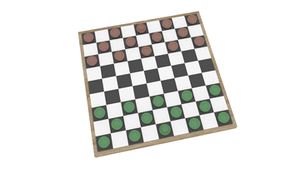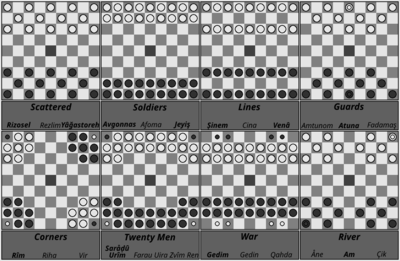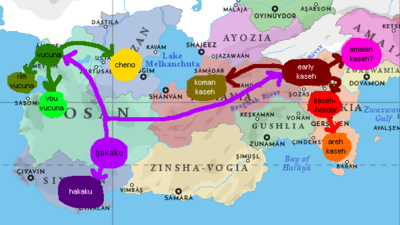Kaseh
 Scattered starting position for Kinged Kaseh on an 9×9 draughts board | |
| Years active | at least 1,000 (early) 600 (modern) |
|---|---|
| Genre(s) | Board game Abstract strategy game Mind sport |
| Players | 2 |
| Setup time | <1 minute |
| Playing time | 30 minutes – 2 hours |
| Random chance | None |
| Skill(s) required | Strategy, tactics |
| Synonym(s) | Kasehokdar, Hokdarez, Katta, Balak Byonam |
Kaseh (Balak: kaseh kaseh [kɑˈsɛh]), also known as Kasehokdar, Hokdarez, Katta, or Balak Byonam, is a two-player draughts game played primarily in Eastern Vaniua and the Balak cultural sphere. It is distinguished from other related games by captured pieces not being removed from play, but rather taken under the capturing man as a prisoner to form a tower. If a tower is captured, only the top piece is taken under the capturing piece's tower. Another notable difference is the more restricted selection of possible starting arrangements in Kaseh, although other layouts popular in other draughts games see infrequent unofficial usage.
There are two primary variants of Kaseh as defined by the International Kaseh Society - Plain Kaseh (Balak areh kaseh areh kaseh [ɑˈɾɛh kɑˈsɛh]) and Kinged Kaseh (Balak: qakceseh kaseh qakşeseh kaseh [ˌhɑkʃɛˈsɛh kɑˈsɛh]) - which differ based on the lack or presence of king pieces. Plain Kaseh is now considered to be the default variant, and is the most popular. All variants of Kaseh are played on a 9x9 checkerboard.
Rules
Setup
Two players sit across from each other, picking either colour they choose; the most common colour pairs are red/light and green/dark. The game's pieces are set up in one of a number of starting arrangements; Kaseh makes use of either the Scattered, Soldiers, or Lines arrangement, with Scattered being by far the most common both in informal and standard/international play. If Kinged Kaseh is being played, the centre warrior in the row closest to each player is promoted to a king, giving each player a single king piece. The green player goes first, moving any piece they choose. The two players take turns moving their pieces diagonally, to the next diagonally adjacent free tile, to eliminate all of their opponents' warriors.
Pieces and movement
Warriors
Uncrowned pieces, known as warriors in Kaseh (Balak ḑen jen, plural ḑeyic jeyiş) move one step in any direction diagonally to an adjacent space, forwards or backwards. The target space must not be occupied by another piece. If a warrior starts its movement from the centre square of the board, it can optionally move an additional space in a given direction. It is also possible to capture an opponent's piece from one square further away when moving from the centre, provided that the path to do so is unobstructed.
Kings
Kings (Balak qak qak, plural qağac qağaş) are only present in Kinged Kaseh, and like in other draughts games are distinguished through the addition of a small crown piece placed on top of a warrior. They can move diagonally along any number of vacant squares, and can capture from any distance, provided that the path to do so is unobstructed. This behaviour has earned these pieces the nickname "flying kings" (Balak venēh qağac vêneh qağaş), in contrast to a "sitting king" in Cheno.
Capturing
If an adjacent square contains an opponent’s warrior, and the square immediately beyond it is empty, a player’s warrior can jump over the opponent’s warrior to capture it. Capturing is not mandatory if it possible can do so; a player can choose not to capture. Once a capture is made, another may be made within the same turn if possible, and so on. In the course of a capture, a warrior may visit a square more than once, as well as jump over an opponent’s warrior more than once. However, it may not double-back and capture from the same tower in two successive moves, i.e. immediately moving back to the square it just came from to capture a second piece from the tower. Kings can capture an opponent’s piece from any distance, though they can only make a single capture, as opposed to warriors which can make multiple captures in one turn. If a king captures a piece, it can not move any further than the square immediately beyond the captured piece.
Towers
Unlike in other draughts games, captured warriors are not removed from play, but are taken along under the capturing warrior as a prisoner (Balak gujvanvir gucvanvir, plural gujvanviric gucvanviriş) to form a tower. These towers can reach any height, but by the nature of the capturing system prisoners will always be below the opponent’s warriors, never in between them. If an opponent’s tower is being captured, only the top warrior is taken under the capturing warrior as a prisoner. If the last of an opponent’s pieces on a tower is taken and prisoners are liberated as a result, control of the tower is handed back to the player who owns the prisoners. The tower cannot be broken apart aside from through capturing, though. Control of a tower is determined by the warrior at the top of a tower; if it’s green, it is for the green player to move, and vice versa. There is no difference in movement rules between towers and regular warriors. Additionally in Kinged Kaseh, the type of piece at the top determines how the tower can move; the tower can only move like a king if the top piece is a king.
Winning the game
The game is won when a player's opponent can no longer make any legal moves. This could be the result of all of a player’s warriors being captured, or all remaining warriors being trapped by their opponent’s. If it becomes impossible for players to capture each other’s warriors, e.g. if all of one player’s warriors are on one colour of squares and all of the opponent’s are on the other colour (particularly in the Soldiers and Lines starting arrangements), the game ends and the player with the most warriors remaining wins. If both players have the same amount of warriors, the game ends in a draw. These win conditions are the same in Kinged Kaseh; the game is not automatically won by capturing the king unlike in King's Vucuna.
Naming
The standard name for the game, Kaseh, derives from Balak kas "to jump". The term in fact refers to draughts games in general, although variant names (usually loaned) or qualifiers are used to distinguish other similar games from Kaseh proper.
History
Kaseh, just like other Vaniuan draughts games, is ultimately descended from an ancient Ohanian board game called Qakakun. A later variant of this game had arrived in what is now modern Balakia by the 8th Century CE as a result of being spread through the Tamir Khanate, and by the establishment of the Kothlen Horde in the 10th Century CE Kaseh in its kinged variant had emerged as a distinct game, although it had not yet acquired its distinctive towers. Kaseh's tower feature is thought to have developed in Asharid-ruled Maram during the 15th Century CE; early rulebooks for this variant now held in the University of Qersheven use the term ehazi "minaret" to describe the towers and the towered draughts variant as a whole, although the threat of punishment for blasphemy resulted in this being substituted for hokdar "tower" early on. Balak merchants spread the game throughout the Great Horde through their travels, contributing to an increase in its popularity across the empire in general and within the Ashar courts in particular. It was during this spread that kingless varieties of Kaseh began to increase in popularity across Balakia as well, having already been established variants in the south of the country.
The International Kaseh Society, then known as the Imperial Kaseh Society, was founded by then-crown prince Jimâşim, an avid player of the game, in 1867 with the aim of codifying and standardising the game's rules, as well as promoting the game both at home and abroad. This was in part inspired by a similar endeavour in Vosan, with King Bavi's founding of the Vos Vucuna Federation in 1824. Smaller regional associations had existed for Kaseh decades prior to Balak unification, some also inspired by such organisations in Vosan, but this was the first time a unified standard ruleset had been created for the game. Both Plain and Kinged Kaseh were codified as official variants by the IKS. Throughout the colonial era, the game spread to colonies of the Balak Empire in Puzimm and Lahan with little variation as a result of standardisation. As emperor, Jimâşim was known to personally invite foreign dignitaries and heads of state to play the game with him, particularly during state visits or negotiations, the most famous example being a well-publicised game he played with Emperor Vizedhe of Vosan during negotiations for the Treaty of Kavam. Although both variants had been made official, the original Kinged variety began to wane in popularity in the lead-up to, and during, the Balak Revolution.
The Imperial Kaseh Society was rebranded as the International Kaseh Society under the Kúúlist regime of the Union of Shomosvan, under which the game was promoted as a way of training the mind for strategic thinking and problem solving, as well as proving the superiority of the Kúúlist intellect.
Sport
Official Kaseh tournaments are hosted regularly in Qersheven by the International Kaseh Society, now an independent organisation, under official IKS rulesets.

